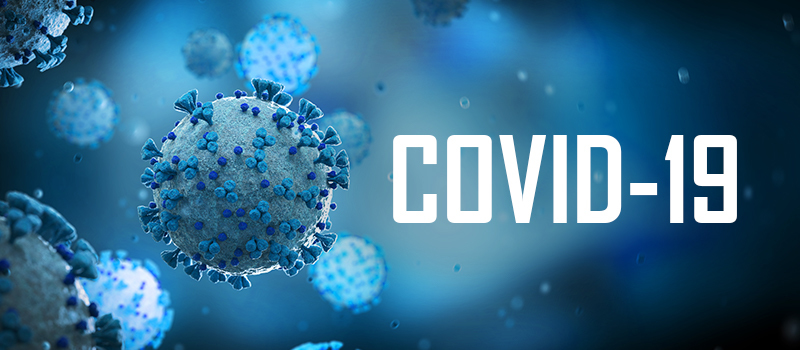
What is COVID-19?
COVID-19 is a viral infection, specifically caused by Severe Acute Respiratory Syndrome-Coronavirus 2 (SARS-CoV 2), that primarily targets the epithelial cells of the lungs, as well as the heart, gastrointestinal tract, and other organs. Once inside the body, the viral proteins bind to, and then fuse with, the membranes of host cells. The viral ribonucleic acid (RNA) hijacks the replication machinery of the cell to create more viral proteins, which form new viral particles that are released to infect neighboring cells.
Although humans have seen pandemics like this before, according to Toxicologist Carla Kinslow, Ph.D., Director, Rimkus Toxicology and Food Safety Division, scientists worldwide are still in the early stages of learning about the virus and its infectious pathology, genetics, and treatment options. People on the front lines of the fight against the virus are studying early cases and applying that knowledge to the treatment of other patients, as well as examining viruses that may be similar to COVID-19 in order to learn more.
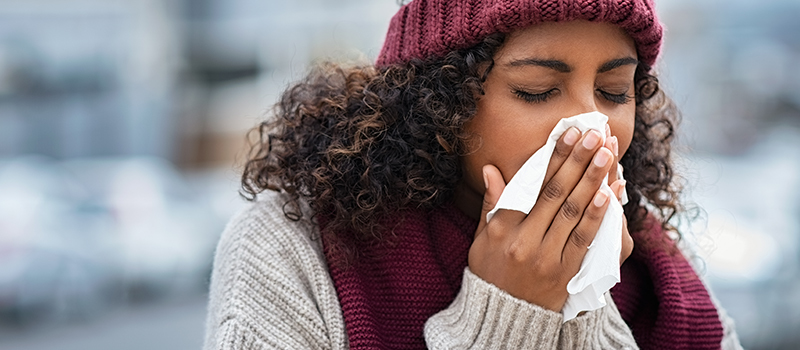
How is it transmitted and what else do we know?
The virus can be transmitted from person to person via respiratory droplets and being aerosolized through coughs, sneezes, or simply talking closely to someone who is infected. It can also be transmitted through touch, specifically hand-to-face contact.
Viral particles can be shed before symptoms appear (asymptomatic) and during the appearance of symptoms, as well as more than a week after the end of symptoms. Recent preliminary data indicates that the number of asymptomatic people carrying the virus without showing symptoms may be very high and people are testing positive for the virus for up to at least a month after showing no symptoms.
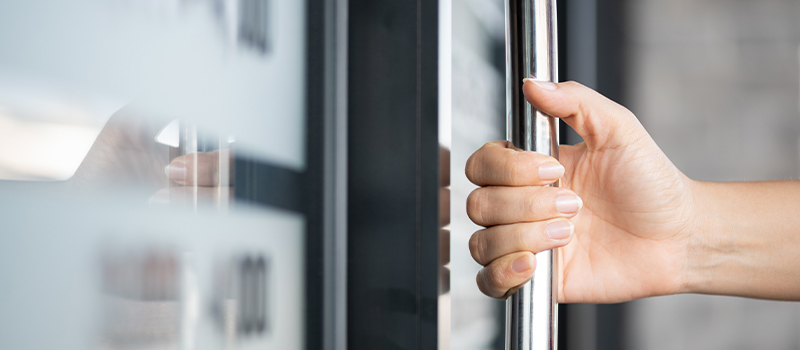
Why test spaces?
There are high levels of fear and misinformation surrounding the virus. Building owners and property managers must address the need for spaces to be occupied while assuring occupants that due diligence has been performed concerning the mitigation and continued control of the virus.
To offer peace of mind to tenants as they return to their spaces, mitigation measures can be documented and confirmed through cleaning verification testing, which ensures that decontamination efforts have been performed correctly. Building owners and property managers may also be responsible for fulfilling contractual obligations with clauses regarding a decontamination response or plan of action. Historic data indicates there will be another peak of infection; mitigation and continued decontamination plans, along with cleaning verification, may become the norm for many public spaces.
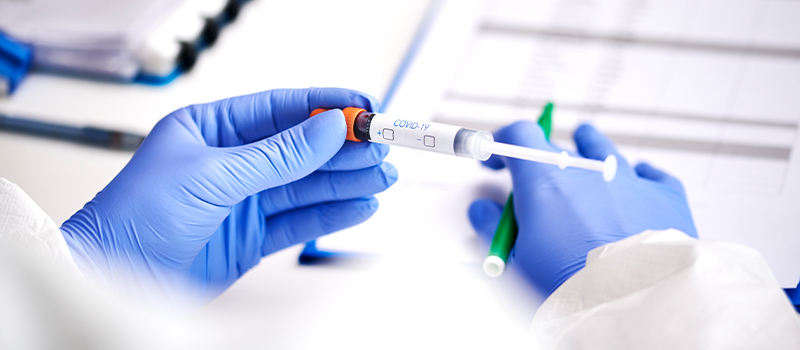
Testing/Equipment
Polymerase Chain Reaction (PCR) testing is a test that can be performed to identify the presence of SARS-CoV-2 genetic material on surfaces in order to determine if a workspace has been impacted by the virus. Samples are sent to a laboratory for analysis and results can be produced within 24 hours.
Adenosine Triphosphate (ATP) testing is recommended for post-decontamination cleaning verification testing. This technology is a real-time meter that provides a quantifiable measurement of microorganisms from a given sample. For this testing, a swab is moistened, swiped on a surface, and inserted into a meter for analysis. This equipment is a staple in the food and healthcare industries for rapid identification of the cleanliness of surfaces. ATP testing does not test directly for viruses; however, it tests indirectly by measuring organic material (ATP) that should have been removed along with viruses. ATP testing is a way to confirm overall cleanliness after a cleaning.
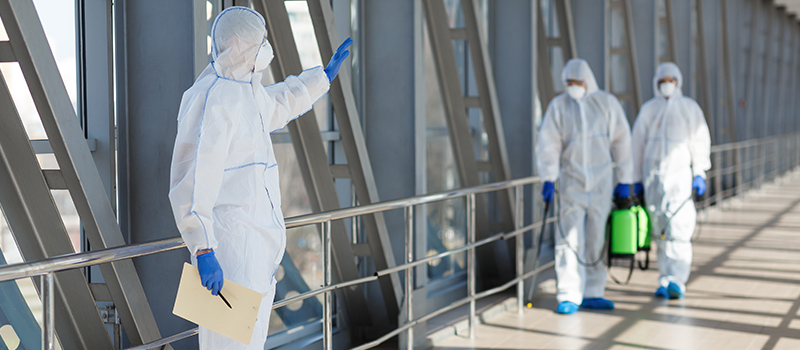
Decontamination
SARS-CoV-2 viral particles can take several hours to settle on surfaces through the air and can be active on these surfaces for several days. The virus has a weak, vulnerable outer membrane and is susceptible to breakdown from both a chemical and physical standpoint. Washing hands with soap and water physically removes the virus from the surface of your hands as well as inactivates it.
The Environmental Protection Agency’s “List N” has more than 370 entries of chemicals approved for disinfectant use against SARS-CoV-2. The list provides the contact time of these disinfectant chemicals, which can break down the virus as long as they are allowed enough dwell time to be effective.
Decontamination of public spaces involves determining which surfaces to clean, including assessment of high-touch surfaces, as well as the scope of the entire cleaning process. Depending on the circumstance, this could require janitorial, maintenance, or third-party cleaning and restoration services.
Kieran Purcell, P.E., LEED AP, Director, Rimkus Environmental Division, recommends beginning with physically removing matter from surfaces by wiping them down with soap, water, and disposable microfiber cloths using a single-wipe motion. Once surfaces have dried, disinfectants should be applied to high-touch surfaces. In unique circumstances, electrostatic misting/fogging and the use of ultraviolet (UV) lighting and ozonation of unoccupied spaces may also be utilized to offer additional reassurance regarding decontamination efforts.
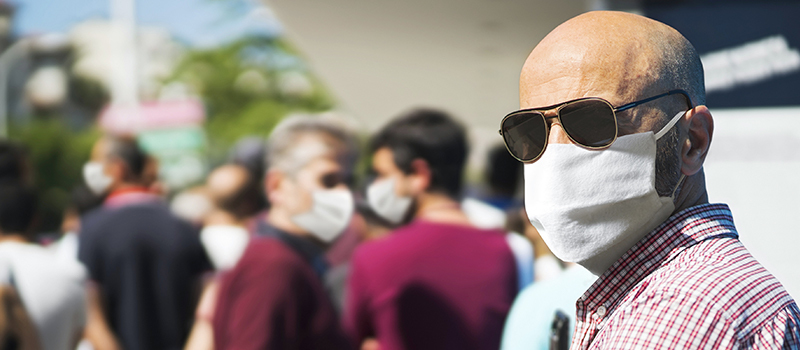
Re-Entry Protocols
Once occupant safety has been ensured via cleaning measures, the health of building systems should be evaluated. During shutdown, many building systems, including plumbing, air conditioning, electrical, elevators, alarms, fire protection, and more have been turned off or running at reduced use for long periods of time. Jeff Peters, P.E., CEICC, Rimkus Vice President and National MEP Division Manager, recommends evaluating these systems before bringing them back to full use.
Because warm, stagnant water can allow Legionella and other organisms to grow, plumbing systems need to be restarted and flushed.
Electrical systems may not need as much maintenance but should also be reviewed for updates, such as the addition of touchless controls to otherwise high-contact surfaces. For continuous disinfection, upper level air ultraviolet germicidal irradiation (UVGI) light fixtures may be considered.
Heating, ventilation, and air conditioning (HVAC) systems should not need special cleaning for viruses; however, issues may still arise due to prolonged system shutdown or idling. Systems should be purged with fresh air if stale or chemical odors have developed during shutdown. Thorough cleaning will be required if high humidity has caused mold growth. Filter maintenance is also encouraged; protective equipment should be worn during this process.
Elevator maintenance issues should be addressed and new socially distant procedures for elevator use may need to be established.
Screening and safety procedures for re-entry of buildings by staff and guests should be established. This may include temperature screening processes; purchasing/providing hand sanitizer, face masks, or other protective equipment; defining physical distance guidelines; and installing directive signage.
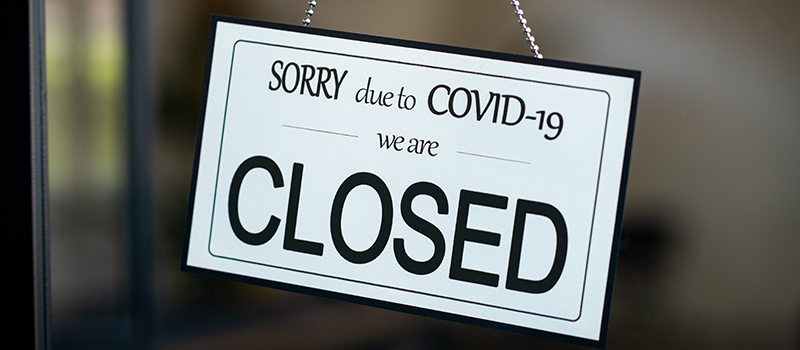
Business Interruption
The pandemic has affected the ability of many businesses to remain open, maintain operations at pre-pandemic levels, or fulfill contractual obligations, all which can result in economic losses; however, some financial loss recovery is possible.
Compensable and non-compensable remedies to business interruption may include business interruption insurance claims and/or contractual relief claims. There may be other remedies for which building owners and managers should seek legal advice, including the Uniform Commercial Code (UCC), provisions within contracts for international sale of goods, various legal doctrines in common law for tort claims, and government relief in the form of subsidies/stimulus packages.
Insurance policies should be thoroughly reviewed with respect to business interruption; the assistance of legal counsel is recommended. Policies, such as Subcontractor Default Insurance (SDI) and surety bonds, may contain provisions for recovery of losses due to contractor defaults that arise due to financial incapacity during pandemic situations.
Timothy Brashear, P.E., Director, Rimkus Construction Services, suggests that contracts should be thoroughly reviewed with the help of legal counsel. Specifically, contracts may contain force majeure provisions or other clauses that may provide contractual relief or can excuse non-performance when it is rendered impossible or impractical due to an event beyond the party’s control.
Commence with an action plan to investigate the potential relief within all insurance products and business contracts and agreements. Establish a risk mitigation plan for all operations and projects and seek assistance from consultants with experience in business and contract suspensions.
Develop a risk inventory that includes lists of insurance products and contracts, an investigation of owner finance viability and business capital, site protection evaluation, and contemporaneous records of pre-pandemic suspension productivity/status and losses as well as other considerations. Update and monitor inventory processes with a grading system that ranks projects and prioritizes those with the fewest remobilization risks.
Learn more about our team of more than 500 industry experts who can help facilitate a seamless and successful transition back into public spaces and the new normal.

